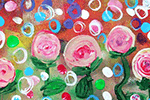The Children's Art Book
Oil Pastel Techniques
Unlike oil paints and water colours, oil pastels are clean, safe, easy to work with, needs almost no preparation (no mixing or diluting required!), and are easy to transport. Children especially love oil pastels for their bright, vibrant and lasting colours.
Include oil pastels into your child’s art kit, so when the creative itch strikes, all you need is paper and your oil pastels are already at your disposal!
Choosing Your Oil Pastels
Oil pastels are generally available in two forms, soft or hard. Soft oil pastels create almost painting-like effects, and even impasto, with its smooth and waxy texture.
Hard oil pastels are easier to work with, since they do not stick to your fingers, and are more apt for drawing, sketching detailed works, including blending and overlaying effects.
Depending on the type of artwork, you may use soft or hard oil pastels, or sometimes both! Younger children generally start off with soft oil pastels as they generally apply better onto paper, and can cover more area quickly. Older children will appreciate the precision that hard oil pastels provide, especially when colouring detailed portraits or landscapes.
Pastels used by professional artists contain better and more pigments within the binder. This allows colours to last longer, appear bolder and more vibrant.
Pastels for students may contain less colour pigments, and more binder. Although the colours may be less vibrant, they tend to be softer, easier to apply and less likely to flake. Since there are less pigments, oil pastels used for school goers tend to be more affordable.
We recommend purchasing a set of student quality oil pastels for a start. They are suitable for most mediums, and not too expensive to replace if they are misplaced (children can and will break and lose their pastels!) Most also last sufficiently long for most children’s artworks.
Techniques
There are many techniques which children can use with oil pastels, and most artworks actually feature a hybrid of techniques. Here are some basic techniques which children of all ages can use to create beautiful oil pastel artworks!
Dotting
With the edge of an oil pastel, create dots by making gentle hits on the paper. If you wish, pull softly along the paper to make short dashes from dots. Children especially love oil pastel dotting with rain drops.
Blending
Apply one area with an oil pastel colour, and another colour adjacent to it. Blend to smooth the boundary between both colours with your fingers. It’s common practice for children to blend one colour on top of another, as long as the oil pastel is rubbed clean with a towel after!
Overlaying
Apply a base (background) oil pastel colour over an area. With the broad (lay the oil pastel horizontally), rub the oil pastel and layer a second colour over the base colour. Use overlaying if you wish to create a coarser blend of colours.
Scratching
Layer two or more different oil pastel colours, one on top of another. Apply pressure strokes and scratch over the top layer of oil pastel with a sharp edge (a painting knife, (satay) stick or a fork), to magically reveal the oil pastel colours underneath. Vary the pressure of your strokes and the number of colour overlays, the more fun children can have creating their secret drawings. Best effects are obtained with a dark top layer, or layers with contrasting colours.
Impasto
In oil paintings, the impasto effect is achieved where paint is applied in very thick layers to reveal brush or painting-knife strokes. Rub an oil pastel against paper or a rough surface to gather a soft paste with clay like consistency. To achieve the impasto effect with oil pastels, apply this paste by pressing down and smearing in cover your desired area with your finger, or painting tools like palette knives.
Stencilling
Stencilling allows children to achieve beautiful sharp edges of the objects when colouring. Create a stencil by first drawing your pattern on paper, then cutting the pattern out. There are two ways to use the stencil, either colouring to fill the cut-out area and all of its edges, or in a reverse manner by colouring over the edges of the cut-out and onto the drawing paper. Remove the stencil to reveal your drawing with distinct and beautiful edges. For younger children, have some fun kicks by rubbing oil pastels around the edges with the fingers.
Masking
Masking is more involved and detailed stencilling. Instead of using stencil shapes, masking tape is applied onto your medium (such as paper), to cover complex shapes, or to create unique patterns with tape one on top of another! With the masking tape exposing only areas to be coloured, apply oil pastel liberally over the area. Remove the tape carefully to reveal intricate colourings with clean sharp lines.
Water-colour Resist
With oil or waxed as binders, oil pastels naturally repel and “resist” water-based paints. Watch how water-colours create a unique resist edges as you paint water-colours over oil pastel strokes or areas. Some children will realise that masking is actually a form of oil pastel resist achieved with masking tapes!
Adjusting Oil Pastel Hardness with Temperature
Oil pastels may harden if unused for some time, which may make colouring challenging, especially if you are used to soft pastels. Warm oil pastels by rubbing off the stick, or blow hot air over the pastel for sometime. This softens the oil pastels for a better application. If you need to build more layers of colours quickly, but your artwork is still too soft for another layer of oil pastel, you can cool your artwork in the fridge to harden the existing layers. For best effects, use your fridge-cold artwork with warm oil pastels!











